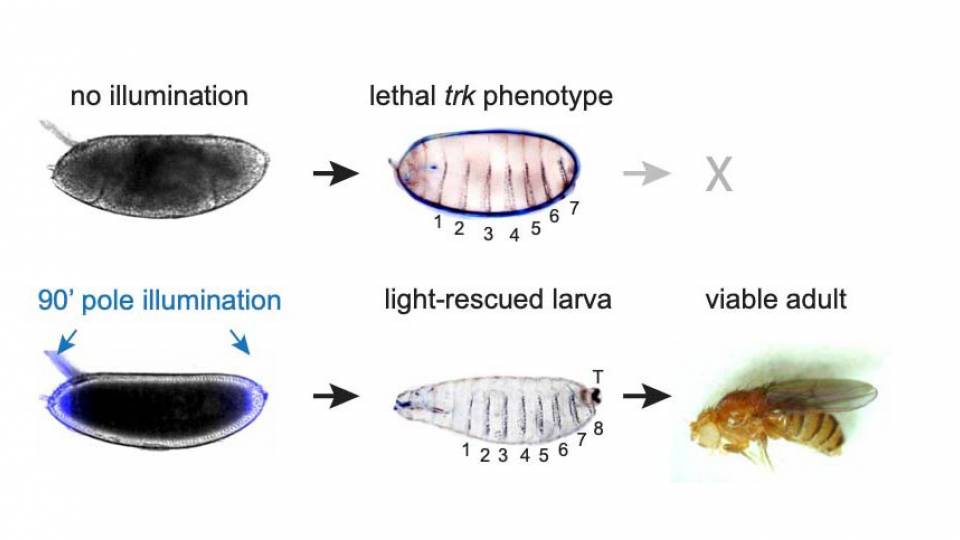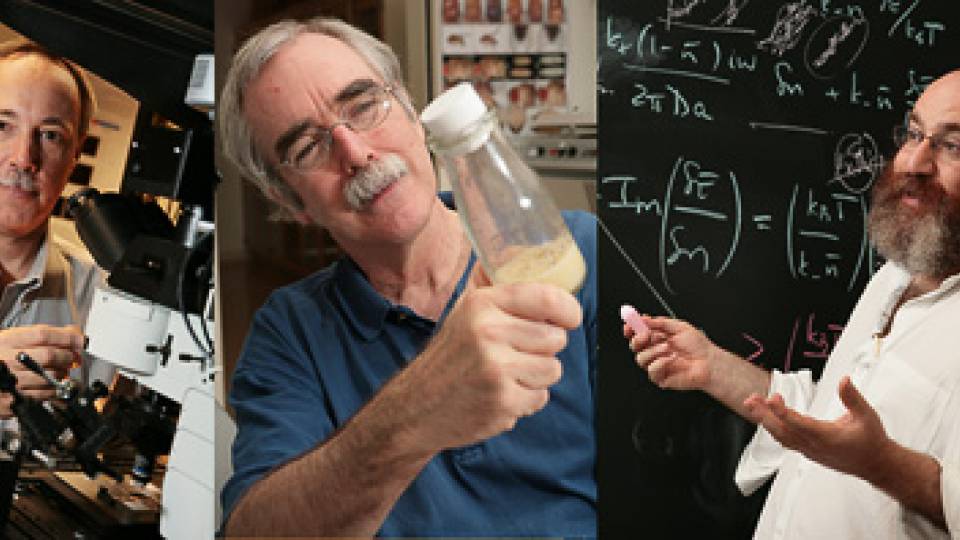Princeton researchers have developed a new method to better understand how an embryo's basic molecular makeup helps ensure that the embryo's development occurs reliably every time.
A team led by Thomas Gregor, an assistant professor of physics and the Lewis-Sigler Institute for Integrative Genomics at Princeton University, and Shawn Little, a visiting postdoctoral research associate in the laboratory of Professor Eric Wieschaus in the Department of Molecular Biology at Princeton, has published in the March 1 issue of the journal PLoS Biology results of research into the fruit fly Drosophila that introduces a method for making precise measurements of biologic units (so-called mRNA molecules) that play a key role in development. The work addresses a recent controversy in the field that raised questions about a classic model that assesses these biologic processes.
"In summary, our paper introduces a novel method of mRNA quantification to the world of Drosophila," Gregor said. "We have used the method to further the quantitative understanding of the bicoid morphogen gradient, which remains the prime example of morphogen-mediated embryonic patterning. We anticipate that the power of our method will be widely applicable to quantitative analyses of many interesting developmental processes of embryonic patterning and mRNA metabolism, both in the context of fruit fly embryos and in higher organisms such as mammals."
In addition to Gregor and Little, other researchers involved in the study included Wieschaus, a Howard Hughes Medical Institute Investigator at Princeton’s Department of Molecular Biology, former Princeton physics graduate student Gašper Tkačik, now at the University of Pennsylvania, and former Princeton undergraduate Thomas Kneeland, who graduated with a degree in physics in 2010.
Little and Gregor describe their findings as follows:
"Embryonic development is the remarkable phenomenon wherein an organism starts as a single cell -- the fertilized egg -- and somehow manages to convert that one cell into many cells of different types. All these different cells organize themselves into diverse tissues and organs that together perform all the functions needed to sustain life. Even more remarkable is the observation that the whole process happens so reliably: For any given animal, all developing embryos of the same age are essentially indistinguishable. And even at the bigger scale, we all have five fingers, and we know very few people who have four or six. Development is a surprisingly well functioning, well organized natural phenomenon, and very few engineering toys have be able to match such accuracy.
"The big question we want to ask is how are biologic molecules arranged inside the embryo so that embryonic development occurs reliably every time. To address this question, we need sensitive methods that allow us to visualize different biologically important molecules in the intact organism.
"In this paper, we develop a powerful and sensitive method to see messenger RNA (mRNA) in embryos of the fruit fly 'Drosophila melanogaster.' We have applied this method to understand how early development is influenced by the spatial arrangement of mRNA for a gene called 'bicoid.'
"The function of bicoid in patterning the embryo has been under study for more than 25 years. The bicoid protein is a transcription factor controls gene expression of cells along the anterior-posterior body axis of the fly body plan. Bicoid protein is found in a concentration gradient extending far into the posterior. High levels at the anterior end activate anterior specific genes, and low levels closer to the posterior activate posterior genes. Classic work published more than 20 years ago demonstrated that the bicoid mRNA, from which the protein is translated, is found only in the anterior portion of the embryo. The disparity between 1) the broad protein gradient and 2) the tight mRNA gradient from which the protein is made, led to a model in which the protein gradient forms by movement away from the source mRNA.
"The spatial distribution of bicoid protein is consistent with the gradient forming through simple passive diffusion from its anteriorly localized source. The bicoid gradient thus was the first demonstrated example of embryonic patterning via a morphogen, a factor whose concentration dictates gene expression in a dose-dependent manner. The theoretical concept of a morphogen had been proposed decades earlier, but these results provided the first clear demonstration that a morphogen actually exists in nature. Subsequently, many additional morphogens have been discovered. The model of the bicoid morphogen gradient, forming via protein movement from the anterior to the posterior, has since served as the prime example of morphogen-mediated patterning and has become a cornerstone in textbooks of developmental biology. The relative simplicity of gradient formation has also made bicoid an attractive model for computational biology and biophysics.
"Recent innovations in fluorescent labeling of proteins and mRNAs have made it possible to measure the amounts of these molecules with more precision than was possible when those classic studies were performed in the late 1980's. In our current work, we develop a novel, sensitive assay for visualizing and measuring bicoid mRNA. Our method allows us to detect mRNAs as discrete particles by fluorescence microscopy. No prior study has been capable of globally documenting bicoid mRNA at this level, and we therefore provide the most accurate description possible of its spatial distribution. Further, we compare bicoid mRNA to Bicoid protein. We show that the mRNA is present in a nearly unchanging spatial distribution along the anterior-posterior axis during embryonic development. Nearly all (more than 90 percent) of the mRNA is confined to the anterior 20 percent of the embryo. This unchanging distribution is remarkable, because the global architecture of the embryo changes continuously during early embryogenesis as the future cells divide rapidly and repeatedly to give rise to 6,000 cells from one.
"In addition, we document the dynamic evolution of the bicoid protein gradient during early embryogenesis, making precise protein measurements which were unavailable previously. By comparing the mRNA and protein distributions over time, we reinforce the classic model of protein movement away from a localized source. Moreover, we use our measurements of mRNA in a mathematical simulation of protein production to show that the spatial spread of the mRNA across the anterior 20 percent influences the formation and dynamics of the protein gradient. Importantly, our simulation employs our actual mRNA measurements. In contrast, all previous models of gradient formation used hypothetical or otherwise unrealistic spatial distributions of mRNA, and did not incorporate the actual protein dynamics that we document. Therefore, our analysis has produced a more complete picture of gradient formation, and emphasizes the need to incorporate precise quantitative measurements into any mathematical model of biologic processes.
"In addition to providing a highly refined picture of the bicoid gradient, we have addressed a recent controversy in the field. In 2009, a group published a paper challenging the legitimacy of the classic, textbook model of gradient formation through protein movement. Instead, they attempted to visualize and quantify bicoid mRNA using a low-resolution, relatively insensitive method.
"Their method, unlike ours, was unable to discern discrete particles of bicoid mRNA. Despite this limitation, this group presented data suggesting that movement of mRNA, -- and not protein -- from the embryo's anterior toward its posterior is responsible for the formation of the protein gradient. Unfortunately, neither the authors nor the reviewers of that paper were aware of the technical pitfalls associated with quantification of fluorescent signal. The authors were misled by their analysis into believing that the mRNA moves over time in the embryo, which led them to question the classic model of protein movement. In our paper, we point out the difficulties and technical shortcomings of the prior group's analysis, and affirm the classic model of gradient formation by protein movement."
Gregor is available to discuss the research with interested members of the news media, and a copy of the study is available upon request. Members of the media wishing to contact Gregor are encouraged to e-mail him at tg2@Princeton.EDU.
The research was supported by the Howard Hughes Medical Institute and the Searle Scholars Program.




